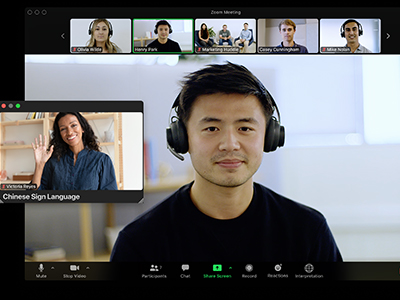Zoom Announces New Features in Support of Sign Language

In October 2022, Zoom announced a new dedicated channel for sign language interpreters. The new feature allows one or more participants in a Zoom meeting to be assigned a role of “Interpreter” by the host, and assigned a specific language, such as “American Sign Language.”
Once interpreters are assigned, all meeting participants are notified that sign language interpretation is available, and an “Interpretation” button is added to the control bar at the bottom of the Zoom screen. If participants click this button, they’re presented with a choice of available languages. After selecting their preferred language, an interpreter window appears. It’s separate from the main Zoom window, so it can be resized and repositioned independently of the Zoom interface. If there are multiple interpreters for a given language, they share the same interpreter window but only one interpreter is shown at a time. They can hand-off to each other by toggling their video on and off.
This new feature offers an alternative to interpreters being regular participants, whose videos can be moved to the forefront by “pinning” (by individual users to customize their own view) or “spotlighting” (by the meeting host, for all users). This original model is delicate, as participants’ windows within Zoom share space with all the other Zoom features, such as the speakers’ video windows and shared screen. The new feature eliminates all confines and allows the interpreter to be anywhere on the screen, at any size.
Documentation from Zoom about these features is available for different audiences. Meeting owners and hosts should visit Managing Sign Language Interpretation. Participants can visit Viewing Sign Language Interpretation.
AccessComputing staff has been actively testing this new feature and providing ongoing feedback to Zoom’s accessibility team. There are a few known limitations. For example, as of November 2022, the interpreter window is not captured when the meeting is recorded. This limitation is expected to be addressed for cloud recordings in an upcoming release. A second problem is that the interpreter channel only works in the main room, not in breakout rooms. Interpreters can be assigned to breakout rooms, but in the breakout room they become regular participants again, so participants who need their services will need to fall back to the old way of doing things (e.g., pinning and spotlighting), until they return to the main room. A third problem is that interpreters by default do not have the ability to unmute themselves so they can speak on behalf of a participant. The host must change a setting for each interpreter to allow them to speak, which is burdensome for the host and adds an extra layer where things can go wrong.
If you have feedback you’d like to share with Zoom about their accessibility, send it to tft@uw.edu, and we will relay your feedback to the Zoom accessibility team.